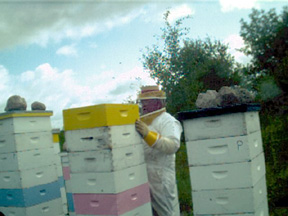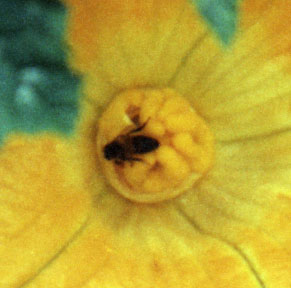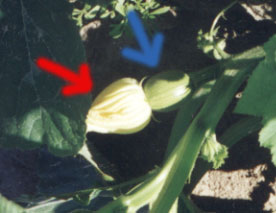
Sorry, no more honey.
Vern has had to retire from the honey business. Thank you for your years of patronage!
The Gourds & the Bees
The flowers on a pumpkin plant are either female or male -- unlike the flowers of many plants, which contain both male and female parts inside the same blossom.

A female blossom is shown above. The inset photo shows the visible bump under the blossom (only on the female blossom) that will become a pumpkin, IF the flower is successfully pollinated by some very important, but often overlooked, farmhands.
A male blossom is shown below.

Just like with other plants, pollen must get from the male flower part (stamen) to the female part (pistil) so that pollination will occur, and seeds will develop. In the case of pumpkins, seed development also means development of a big, orange fruit!
But how does the pollen get where it needs to go?
BEES!
As any schoolkid knows, bees spread pollen as they move from flower to flower collecting nectar. In order to help ensure a bountiful crop, we used to have a beekeeper bring hives of domesticated honeybees to the farm for the summer, and they were placed in a small clearing in the woods next to the pumpkin field.
But starting in 2003, Vern has become a beekeeper himself. Now he's taking care of his own bees. And making lots of good pumpking honey to sell in October.
The bees live and make honey in wooden hives, which are protected by an electrified fence. Protected from what? From the bears, of course! Everyone knows bears love honey, but they especially love to munch on bee larvae -- yuck! A hungry bear could quickly destroy these hives. And there are bears in the area -- fresh tracks were seen in the pumpkin field soon after the bees arrived this year.

Now, don't you worry about the bears. The fence won't hurt them, it just convinces them to change their grocery list. Electricity for the fence comes from a battery, which is recharged by a solar panel (on pole in foreground of photo).
The busy bees enter their hives through an opening at the bottom. Here, bees can be seen milling around at the base of the hive, while others can be seen in flight.

Below, Vern adds another layer onto the beehives, making more room for yummy honey. The rocks on top are to keep the lid from blowing off in the wind.

If the bees do their job getting the pollen from the male flower to the female flower (red arrow, shown with petals closed), the tiny little pumpkin (blue arrow) at the base of the female flower will grow into a big, orange pumpkin!
 |
| 
For more information about BEES and HONEY, we recommend this link to the National Honey Board:
http://www.honey.com/nhb/about-honey/
or try http://www.partstap.com/an-experts-guide-to-all-things-honey.aspx
and here's some info on pollination: http://www.serenataflowers.com/Guide-to-Flower-Pollination
Here's a website tip from Mrs. Fowler's class:
http://www.bigoven.com/article/Recipe/kids-guide-honey
Alejandro in Colorado recommends this page, about the lifecycle of a flower:
http://www.odealarose.com/20-angiosperms
Frannie Davis shares this page on flower anatomy:
http://www.kremp.com/Flower-Anatomy-For-Kids-articles.htm
Florist and education writer Ava Rose (Now she's got a good name for her job!) shared her pollination page:
http://www.avasflowers.com/understanding-flower-pollination
Check out our Cooking page for a pumpkin bread recipe that uses honey as an ingredient.
Please click on the choices below to learn more about pumpkins and the Downing Farm.
[HOME | FARM TOUR | PUMPKIN SALES INFO | PUMPKIN FACTS | COOKING]
[ASK DAISY | CARVING TIPS | [PUMPKINS IN THE CLASSROOM | HUMOR]
[JACK-O'-LANTERN HALL OF FAME | PUMPKIN BOWLING]
[THE COWS | THE BARN | BEES | ANIMAL TALES | FAVORITE LINKS]
[LIFE CYCLE: A YEAR IN THE FIELD]